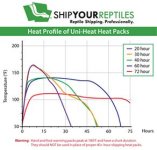jmhherpetology
New member
Hey community,
I haven't posted in a long time and am ready to start being involved again. I recently made a video: https://www.youtube.com/watch?v=kYPLbRfC8Ps
In this video I test the heating efficiency of the 40-hour UniHeat heat pack. Essentially, I used two temperature loggers to track the temperature of the heat pack and an empty deli-cup inside an insulated shipping box. I also tracked the external temperatures with a third temperature logger. At the end of the video, I show what the temperatures were and provide some interpretation and suggestions. I think everyone will be interested to see this.
I haven't posted in a long time and am ready to start being involved again. I recently made a video: https://www.youtube.com/watch?v=kYPLbRfC8Ps
In this video I test the heating efficiency of the 40-hour UniHeat heat pack. Essentially, I used two temperature loggers to track the temperature of the heat pack and an empty deli-cup inside an insulated shipping box. I also tracked the external temperatures with a third temperature logger. At the end of the video, I show what the temperatures were and provide some interpretation and suggestions. I think everyone will be interested to see this.


